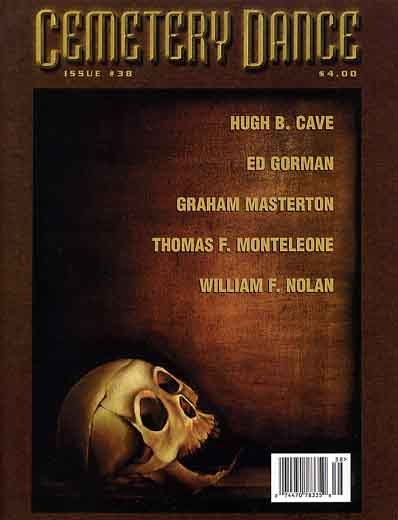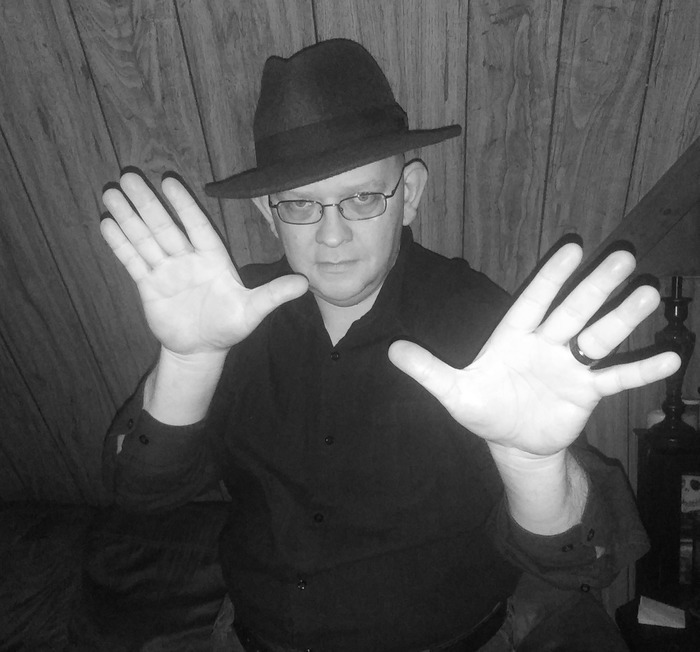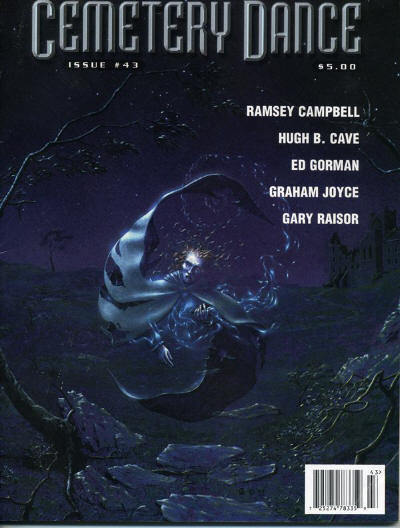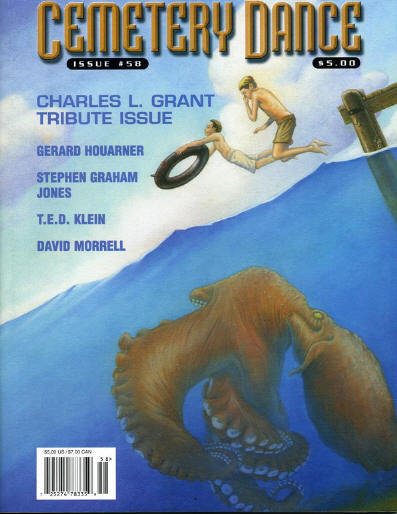
Part of Series
3 • Words from the Editors (Cemetery Dance #38) • [Editorial (Cemetery Dance)] • (2002) • essay by Robert Morrish and Richard Chizmar 4 • Demons, Death, and Desire: A Conversation with Graham Masterton • (2002) • interview of Graham Masterton • interview by William P. Simmons [as by William Simmons] 13 • Neighbors from Hell • (2002) • short story by Graham Masterton 23 • Because I Could Not Stop for Death • (2002) • short story by Ray Nayler 28 • From the Dead Zone: Stephen King News (Cemetery Dance #38) • [From the Dead Zone] • (2002) • essay by Bev Vincent 39 • How Do I Know You're Real? • (2002) • short story by William F. Nolan 42 • Waves of Fear (Cemetery Dance #38) • (2002) • essay by Paula Guran 47 • Janie and the Wind • (2002) • novelette by David Nickle 58 • A Conversation with Ed Gorman • (2002) • interview of Ed Gorman • interview by Richard Mason 61 • A Girl Like You • (2001) • short story by Ed Gorman 67 • MediaDrome (Cemetery Dance #38) • [MediaDrome] • (2002) • essay by Michael Marano 72 • The Mothers and Fathers Italian Association (Cemetery Dance #38) • [The Mothers and Fathers Italian Association] • (2002) • essay by Thomas F. Monteleone 79 • Mr. Mowry Goes to War • (2002) • short story by Hugh B. Cave 84 • Collecting Modern Horror (Cemetery Dance #38) • (2002) • essay by John Pelan 88 • Spotlight on Publishing: Barclay Publishing • (2002) • essay by Joseph Nassie 94 • CD Reviews (Cemetery Dance #38) • (2002) • essay by various
Authors


Graham Masterton was born in Edinburgh in 1946. His grandfather was Thomas Thorne Baker, the eminent scientist who invented DayGlo and was the first man to transmit news photographs by wireless. After training as a newspaper reporter, Graham went on to edit the new British men's magazine Mayfair, where he encouraged William Burroughs to develop a series of scientific and philosophical articles which eventually became Burroughs' novel The Wild Boys. At the age of 24, Graham was appointed executive editor of both Penthouse and Penthouse Forum magazines. At this time he started to write a bestselling series of sex 'how-to' books including How To Drive Your Man Wild In Bed which has sold over 3 million copies worldwide. His latest, Wild Sex For New Lovers is published by Penguin Putnam in January, 2001. He is a regular contributor to Cosmopolitan, Men's Health, Woman, Woman's Own and other mass-market self-improvement magazines. Graham Masterton's debut as a horror author began with The Manitou in 1976, a chilling tale of a Native American medicine man reborn in the present day to exact his revenge on the white man. It became an instant bestseller and was filmed with Tony Curtis, Susan Strasberg, Burgess Meredith, Michael Ansara, Stella Stevens and Ann Sothern. Altogether Graham has written more than a hundred novels ranging from thrillers (The Sweetman Curve, Ikon) to disaster novels (Plague, Famine) to historical sagas (Rich and Maiden Voyage - both appeared in the New York Times bestseller list). He has published four collections of short stories, Fortnight of Fear, Flights of Fear, Faces of Fear and Feelings of Fear. He has also written horror novels for children (House of Bones, Hair-Raiser) and has just finished the fifth volume in a very popular series for young adults, Rook, based on the adventures of an idiosyncratic remedial English teacher in a Los Angeles community college who has the facility to see ghosts. Since then Graham has published more than 35 horror novels, including Charnel House, which was awarded a Special Edgar by Mystery Writers of America; Mirror, which was awarded a Silver Medal by West Coast Review of Books; and Family Portrait, an update of Oscar Wilde's tale, The Picture of Dorian Gray, which was the only non-French winner of the prestigious Prix Julia Verlanger in France. He and his wife Wiescka live in a Gothic Victorian mansion high above the River Lee in Cork, Ireland.

'Simmons draws from a well with waters dark and deep, that taste of guilt, despair and fear, to cultivate his surprising and inventive tales of horror.' — ADAM NEVILL (British Fantasy Award Winning author of THE RITUAL and NO ONE GETS OUT ALIVE). William Simmons is an acclaimed author, critic, anthologist, and journalist specializing in supernatural horror fiction. He is an Active Member of the HWA. Eight of his stories received ‘Honorable Mentions’ in The Year’s Best Fantasy & Horror. His collection WE FEED THE DARK received accolades from such horror legends as ADAM NEVILL, ERIC J. GUINGARD, and FORREST AGUIRRE. “Avoiding horror’s traditional icons and their premeasured fright potential ... (Simmons is) a writer whose approach is both original and refreshingly unconventional.”
- PUBLISHER'S WEEKLY His collection BY REASON OF DARKNESS received rave reviews from Cemetery Dance, All Hallows, and Publisher's Weekly, who called him Simmons “…evokes both Ray Bradbury and Joyce Carol Oates.” – PETER BELL, All Hallows His first collection BECOMING OCTOBER sold out quickly upon release, and he collaborated on the Halloween collection DARK HARVEST with author Paul Melznick. His stories have appeared in several venues, including Cemetery Dance, Flesh & Blood, Darkness Rising (1-9), Infinity Plus, Dark Discoveries, and many more. His poetry has appeared in Chizine, Gothic.net, Lullaby Hearse, Dead Cat Bouncing, etc. GRAHAM MASTERTON, author of The Minatou, said Simmons “has the gift of making an ordinary day seem scary.” NANCY KILPATRICK, author of The Goth Bible, said “Simmons has a knack for constructing dark, creepy, introverted tales, full of obscure terrors that reflect nearly mythical realms.” And T.M. WRIGHT, author of Strange Seed, compared Simmons’ horror fiction to “like being taken back forty years and discovering Poe for the first time, and M.R. James, and Shirley Jackson.” Simmons has contributed reviews, essays, and scholarship to Rue Morgue, Publisher’s Weekly, Wormwood, Hellnotes, Gauntlet, Cemetery Dance, and others. His review columns include “Dark Devotions”, “Literary Lesions”, and “Folk Fears”. He contributed an introduction to Falling into Heaven, by Maynard & Sims, and his reviews have been blurbed for several books. As a journalist, he created Our Ladies of Darkness, one of the earlier interview columns devoted to female genre authors, and Beyond the Fifth Dimension: The Twilight Zone Interviews, which spoke with surviving scribes of the influential television series. He also conducted two special chapbook length interviews with Richard Matheson and F. Paul Wilson, both for Gauntlet Press. His reviews have been used as blurbs by Tartan Asian Extreme and he has contributed Liner Notes to DVD releases. “His anthologies are carefully crafted, the stories bleeding into each other with seamless precision.” – MAYNARD & SIMS, Demon Eyes. As an anthologist he has edited the bestselling SEASON OF THE DEAD: SUPERNATURAL HORROR FOR HALLOWEEN (reviewed by Rue Morgue) and the bestselling WILDWOOD: TALES OF TERROR & TRANSFORMATION FROM THE FOREST. His other anthologies are MONSTER CARNIVAL and YULETIDE FRIGHTS. He is the series editor for Shadow House Publishing has several anthologies and single author collections in development. for Shadow House Publishing, including The Library of Weird Fiction and Horror Hall of Fame Novellas.


Hugh Barnett Cave was a prolific writer of pulp fiction who also excelled in other genres. Sources differ as to when Cave sold his first story: some say it was while he still attended Brookline High School, others cite "Island Ordeal", written at age 19 in 1929 while still working for the vanity press. In his early career he contributed to such pulp magazines as Astounding, Black Mask, and Weird Tales. By his own estimate, in the 1930s alone, he published roughly 800 short stories in nearly 100 periodicals under a number of pseudonyms. Of particular interest during this time was his series featuring an independent gentleman of courageous action and questionable morals called simply The Eel. These adventures appeared in the late 1930s and early 40s under the pen name Justin Case. Cave was also one of the most successful contributors to the weird menace or "shudder pulps" of the 1930s. In 1943, drawing on his experience as a war reporter, he authored one of his most highly regarded novels, Long Were the Nights, telling of the first PT boats at Guadalcanal. He also wrote a number of other books on the war in the Pacific during this period. During his post-war sojourn in Haiti, he became so familiar with the religion of Voodoo that he published Haiti: High Road to Adventure, a nonfiction work critically acclaimed as the "best report on voodoo in English." His Caribbean experiences led to his best-selling Voodoo-themed novel, The Cross On The Drum (1959), an interracial story in which a white Christian missionary falls in love with a black Voodoo priest's sister. During this midpoint in his career Cave advanced his writing to the "slick" magazines, including Collier's, Family Circle, Ladies' Home Journal, Redbook, and the Saturday Evening Post. It was in this latter publication, in 1959, that "The Mission," his most popular short story, appeared—subsequently issued in hardcover by Doubleday, reprinted in textbooks, and translated into a number of languages. But his career took a dip in the early 1970s. According to The Guardian, with the golden era of pulp fiction now in the past, Cave's "only regular market was writing romance for women's magazines." He was rediscovered, however, by Karl Edward Wagner, who published Murgunstrumm and Others, a horror story collection that won Cave the 1978 World Fantasy Award. Other collections followed and Cave also published new horror fiction. His later career included the publication in the late 1970s and early 1980s of four successful fantasy novels: Legion of the Dead (1979), The Nebulon Horror (1980), The Evil (1981), and Shades of Evil (1982). Two other notable late works are Lucifer's Eye (1991) and The Mountains of Madness (2004). Moreover, Cave took naturally to the Internet, championing the e-book to such an extent that electronic versions of his stories can readily be purchased online. Over his entire career he wrote more than 1,000 short stories in nearly all genres (though he is best remembered for his horror and crime pieces), approximately forty novels, and a notable body of nonfiction. He received the Phoenix Award as well as lifetime achievement awards from the International Horror Guild, the Horror Writers Association, and the World Fantasy Convention. (From Wikipedia.) Used the pseudonyms John Starr and Justin Case

William F. Nolan is best known as the co-author (with George Clayton Johnson) of Logan's Run—a science fiction novel that went on to become a movie, a television series and is about to become a movie again—and as single author of its sequels. His short stories have been selected for scores of anthologies and textbooks and he is twice winner of the Edgar Allan Poe Special Award from the Mystery Writers of America. Nolan was born in 1928 in Kansas City Missouri. He attended the Kansas City Art Institute and worked as an artist for Hallmark Cards. He moved to California in the late 1940s and studied at San Diego State College. He began concentrating on writing rather than art and, in 1952, was introduced by fellow Missouri native (and established writer) Ray Bradbury to another young up-and-coming author, Charles Beaumont. Moving to the Los Angeles area in 1953, Nolan became along with Bradbury, Beaumont, and Richard Matheson part of the "inner core" of the soon-to-be highly influential "Southern California Group" of writers. By 1956 Nolan was a full-time writer. Since 1951 he has sold more than 1500 stories, articles, books, and other works. Although Nolan wrote roughly 2000 pieces, to include biographies, short stories, poetry, and novels, Logan’s Run retains its hold on the public consciousness as a political fable and dystopian warning. As Nolan has stated: “That I am known at all is still astonishing to me... " He passed away at the age of 93 due to complications from an infection.

